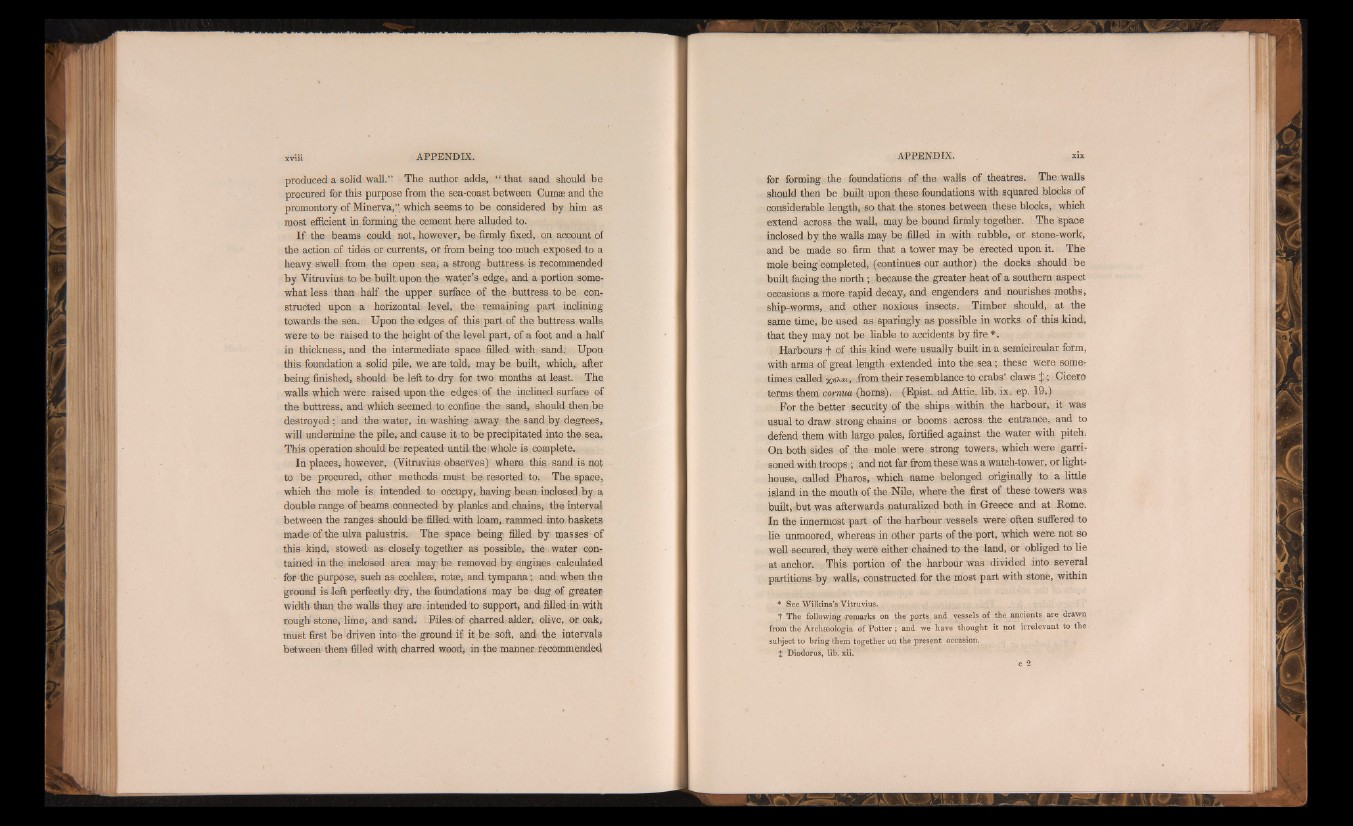
produced a solid wall.” T h e author adds, “ that sand should be
procured for this purpose from the sea-coast between Cumae and the
promontory of Minerva,’’ which seems to be considered by him as
most efficient in forming the cement here alluded to.
I f the beams could not, however, be firmly fixed, on account of
the action of tides or currents, or from being too much exposed to a
heavy swell from the open sea, a strong buttress is recommended
b y Vitruvius to be built upon the water’s edge, and a portion some-
what less than half the upper surface of the buttress to be constructed
upon a horizontal level, th e remaining part inclining
towards the sea. Upon the edges of this part of the buttress walls,
were to be raised to the height of the level part, of a foot and a half
in thickness, and the intermediate space filled with sand. Upon
this foundation a solid pile, we are told, may be built, which, after
being finished, should be left to dry for two months a t least. The
walls which were raised upon th e edges of the inclined surface of
the buttress, and which seemed to confine the sand, should then b e
d e s tro y ed ; and the water, .in washing away th e sand by degrees,
will undermine the pile, and cause it to b e precipitated into the sea.
This operation should be repeated until the whole is complete,
In places, however, (Vitruvius observes) where this sand is not
to b e procured, other methods must be resorted, to. The space,
which the mole is intended to occupy, having been inclosed b y a
double range of beams connected by planks and chains, the interval
between the ranges should b e filled with loam, rammed into baskets
made of the ulva palustris. The space being filled by* masses of
this kind, stowed as. closely together as possible,, th e «water contained
in the inclosed area m a y he removed b y engines calculated
for the purpose, such as cochleae, rotae, and tym p an a ; and when the
ground is le ft perfectly dry, the foundations may be dug; of g re a te r
width than th e walls they are, intended to support, and filled in with
rough stone, lime, and sand. Piles: of charred alder, olive, or oak,
must first b e driven into the ground if it be soft, and the intervals
between them filled with charred wood, in the manner recommended
for forming the foundations of the walls of theatres. The walls
should then be built upon these foundations with squared blocks of
considerable length, so that the stones between these blocks, which
extend across the wall, may b e bound firmly: together. The space
inclosed by the walls may be filled in with rubble, or stone-work,
and be made so firm that a tower may be erected upon it. The
mole being completed, (continues our author) the docks should b e
built facing the north ; because the greater heat of a southern aspect
occasions a more rapid decay, and engenders and nourishes moths,
ship-worms, and other noxious insects. Timber should, at the
same time, b e used as sparingly as possible in works o f this kind,
that they may not be liable to accidents by fire * .
Harbours f of this kind were usually built in a semicircular form,
with arms of great length extended into the.sea ; these were sometimes
called x * » , from their resemblance to crabs’ daw s %; Cicero
terms them cornua (horns). (Kpist. ad Attic, lib. ix. ep. 19,)
For the bette r security of the ships within the harbour, it was
usual to draw strong chains or booms across, the entrance, and to
defend them with large pales, fortified against the Water with pitch.
On both sides of the mole were strong towers, which were ga rrisoned
with troops ; and not far from these was a watch-tower, or lighthouse,
called Pharos, which name belonged originally to a little
island in the mouth of the Nile, where the first ©f these towers was
built, but was afterwards naturalized both in Greece and a t Rome.
In the innermost p a rt of the harbour vessels were often suffered to
lie unmoored, whereas in other parts of the port, which were not so
well secured, they were either chained to th e land, or obliged to lie
at anchor. This portion o f the harbour Was divided into several
partitions by walls, constructed for the most part with stone, within
* See Wilkins’s Vijtruvius.
t The following »remarks on the ports and vessels of the .ancients are drawn
from the Arcliaeologia of Potter; and we have thought it not irrelevant to the
subject to bring them together on the present occasion.
X Diodorus, lib; xii.